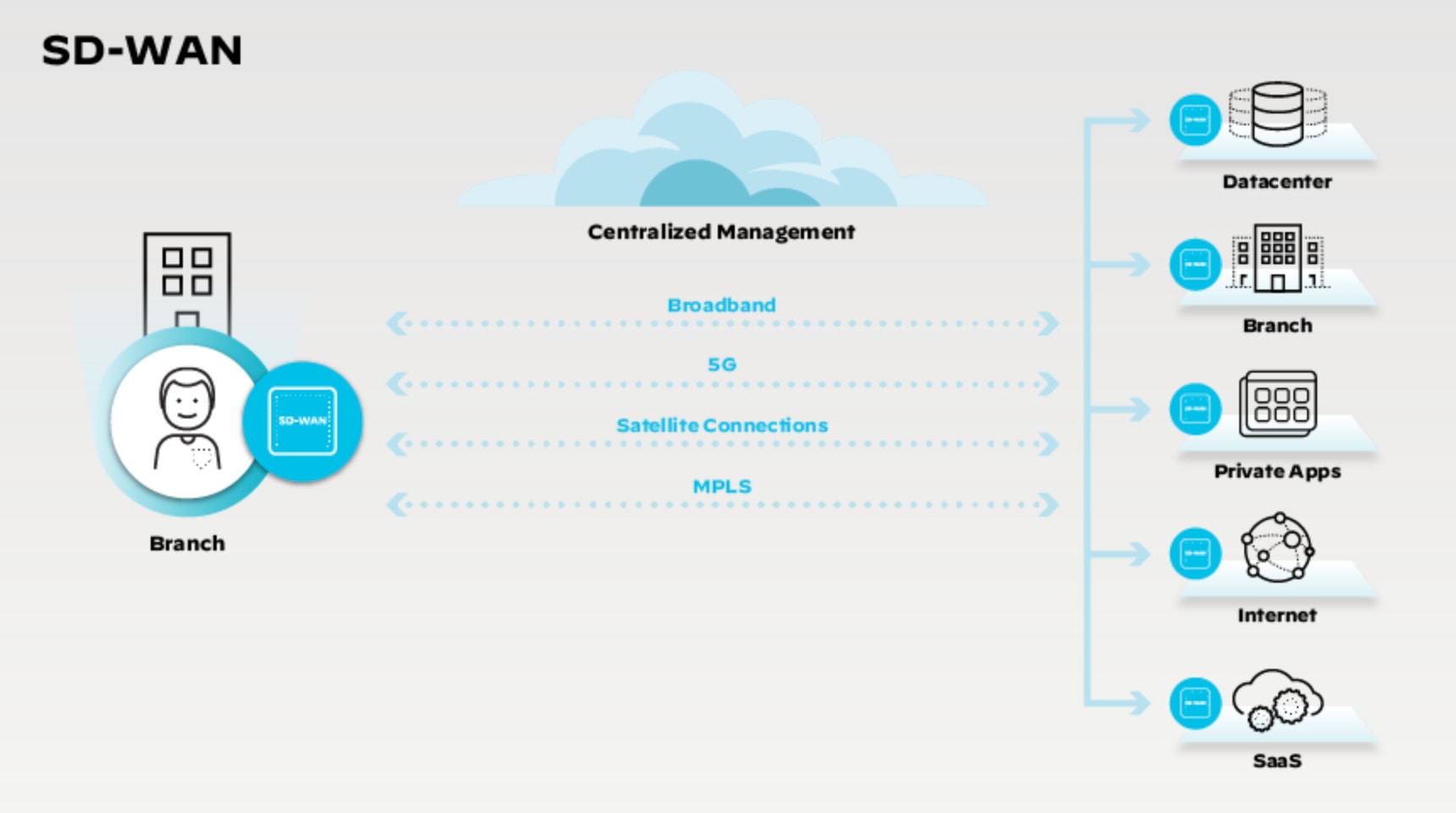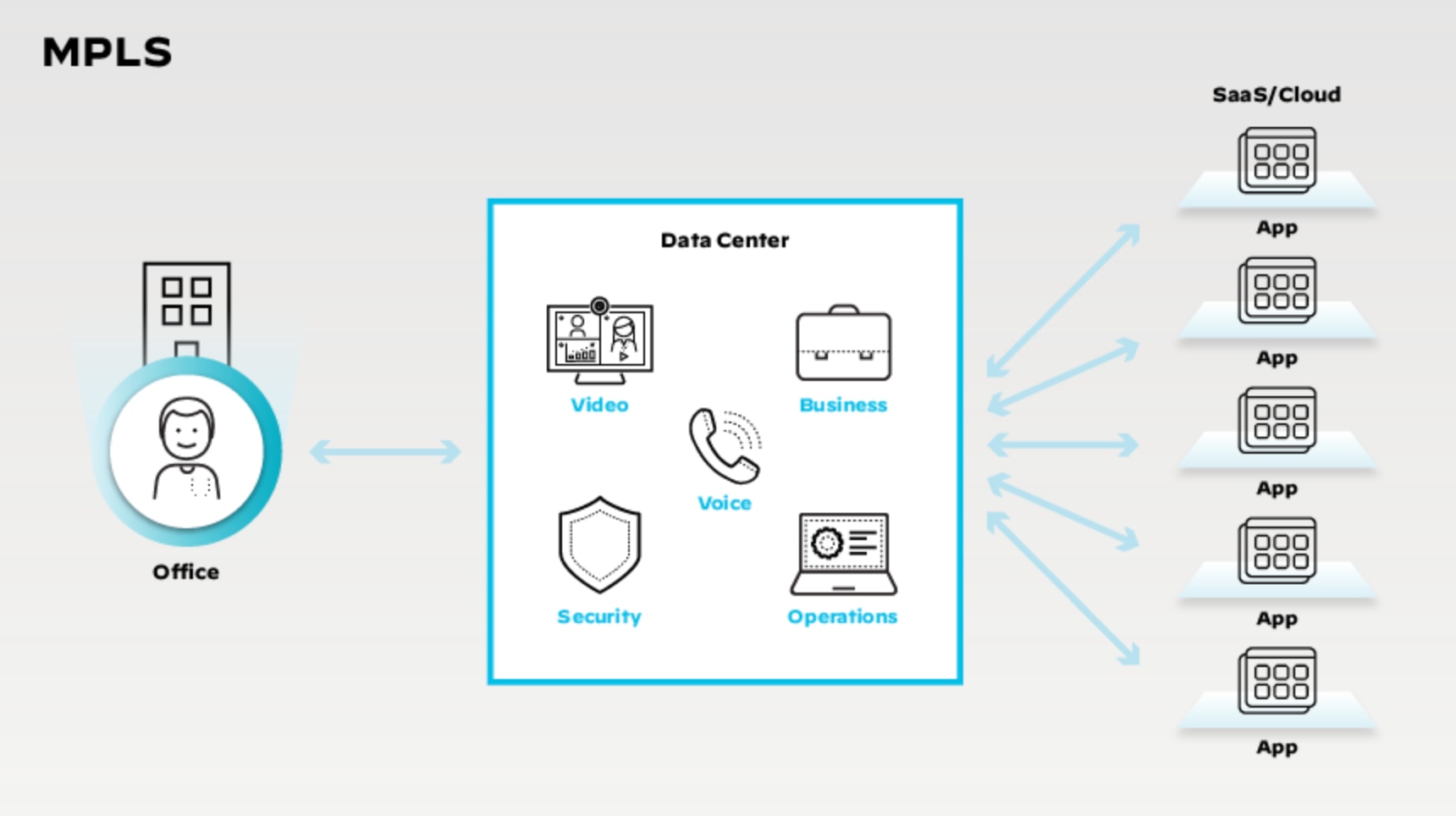What is the Difference Between SD-WAN and MPLS?
MPLS is a protocol improving WAN performance, while SD-WAN is a software-defined approach simplifying WAN management using multiple transport technologies.
Comparing SD-WAN and MPLS
Before diving into the details of how MPLS and SD-WAN differ, it may be helpful to first understand their definitions.
What Is SD-WAN?
SD-WAN (software-defined wide area network) is a technology that simplifies the management and operation of a wide area network (WAN) by decoupling the network hardware from its control mechanism. SD-WAN uses software-defined networking principles to intelligently steer application traffic flow across the multiple WAN transports. This improves performance, security, and flexibility.

Figure 1. SD-WAN Functionality
What Is MPLS?
MPLS (multiprotocol label switching) is a networking protocol that improves performance and efficiency of data transmission in a wide area network (WAN). It operates between Layer 2 (data link layer) and Layer 3 (network layer) of the OSI model. MPLS routes traffic using “labels” that it assigns to a packet and controls the forwarding WAN path based on the shortest available label to improve application performance.

Figure 2. MPLS Functionality
SD-WAN and MPLS are both technologies used for wide area networking, but they differ in several ways.
Pros and cons can be further broken down into three groups, further expanded upon below:
- Performance and reliability
- Cost comparison and ROI
- Scalability and flexibility
- Management and Operations

Figure 3. SD-WAN vs. MPLS
Performance and Reliability
SD-WAN and MPLS offer different approaches to WAN connectivity.
SD-WAN provides carrier-independent connectivity. This provides improved bandwidth availability and WAN redundancy in the event of a network outage. MPLS offers dedicated links suitable for private applications.
SD-WAN enables direct access to SaaS and cloud-based applications. Direct access provides improved performance by eliminating the need to backhaul all application traffic through a centralized data center. MPLS uses a dedicated link with limited bandwidth to access all applications through a centralized HQ or data center and doesn’t meet the demands of distributed applications, which results in poorer performance.
Both have their strengths and complexities to consider for optimal performance and user experience.
Cost Comparison and ROI
SD-WAN solutions offer integrated capabilities, including:
- Routing
- Traffic engineering
- Quality of service
- Security
Consolidating functions reduces costs by eliminating multiple products and management solutions. Plus, granular visibility, automated provisioning, and AI-driven troubleshooting improve SD-WAN return on investment (ROI).
On the other hand, MPLS networks can be expensive–mostly because of bandwidth requirements and performance SLAs. Not to mention, MPLS dedicated WAN links introduce a single point of failure. Adding redundant MPLS connections to improve availability can further increase costs and complexity. Also, centralized MPLS network architecture often causes delays when it comes to accessing cloud and SaaS applications. This leads to a subpar user experience.
Scalability and Flexibility
SD-WAN offers the flexibility of securing applications at the branch, data center, or in the cloud. Most SD-WAN solutions support some form of security policies, such as zone-based firewalls (ZBFW), that allow or deny access to apps, users, and devices. Security focused vendors can support full security stacks that provide next-generation firewalls with both intra and interbranch connections.
The simplicity of managing both network and security policies from a single management console further is another benefit while reducing complexity. Consolidation gives IT organizations better visibility into branch performance and looming cybersecurity threats.
MPLS networks differ in this respect. They require security inspection and threat prevention across all application traffic in a data center. When localized inspection is required for intra- or inter-branch traffic, additional security solutions are needed at the branch level.
Centralized Management
Separate routing and security appliances further compound operational costs and complexity. In contrast, SD-WAN decentralizes WAN networks by using inexpensive broadband, 5G, satellite, and direct internet connections. This method allows users to connect to applications hosted in data centers, the cloud, or SaaS services directly for a lower cost and with higher efficiency.
SD-WAN Vs. MPLS Use Cases
It's important to note that specific use cases for SD-WAN and MPLS may vary depending on an organization's requirements, network architecture, and business objectives. However, common use cases are summarized below.
SD-WAN Use Cases
Secure and Optimized Connectivity
With SD-WAN, organizations can securely connect distributed branches and data centers and cloud resources with multiple network connections. It also provides optimized routing and traffic steering capabilities. This delivers high-performance connectivity and better security, thanks to integrated firewall and threat prevention features.Application Performance
SD-WAN improves cloud-based application performance. This is achieved through intelligent traffic steering and prioritization based on application signatures and application-level SLAs. SD-WAN dynamically selects the best path for each application, resulting in faster, more reliable access to cloud services.Cost Optimization
Organizations can reduce reliance on expensive MPLS circuits with cheaper broadband internet connections using SD-WAN. By opting for multiple network links (e.g., broadband, 5G/LTE, MPLS), organizations can optimize performance and lower connectivity costs.Simplified Network Management
SD-WAN simplifies network operations by centralizing management and control. In this manner, IT teams can conduct network policy activities from one place. Managing distributed environments becomes significantly more simple and agile.Enhanced Security
SD-WAN integrates security capabilities into the network infrastructure. These include:- Next-generation firewalls (NGFW)
- Secure web gateways (SWG)
- Cloud access security brokers (CASB)
The end result is consistent, robust security across all branches and remote locations. Compliance also tends to be easier to address.
MPLS Use Cases
It should be noted that while the use of multiprotocol label switching (MPLS) is not yet obsolete, it is decreasing. Organizations are exploring alternative networking solutions, such as SD-WAN, to optimize cost, flexibility, and cloud connectivity. However, it still has valid use cases.
Private Wide Area Networks (WAN)
MPLS is commonly used by organizations with multiple remote branch offices. It provides a private, secure network infrastructure that connects offices to a central data center. MPLS establishes reliable, efficient communication between branches.Improved Network Performance
MPLS assigned labels to data packets that help routers forward traffic along the shortest path. This results in faster data transmission and less latency. By avoiding complex routing tables and unnecessary hops, MPLS networks can improve network performance for applications such as VoIP, video conferencing, and data transfers.Prioritization and SLAs
MPLS guarantees traffic prioritization that can help improve performance for critical applications like real-time and business critical apps. The providers acknowledge the shaping, queuing, and drop rates, which ensures end-to-end performance delivery. In addition, MPLS has service level agreements (SLAs) that must be met at all times. Any degradation is identified and resolved by the provider within the contractual agreement that ensures application performance.Enhanced Security
MPLS does offer some of its own security benefits, as it inherently provides a higher level of security compared to the public internet. It establishes a private network infrastructure that isolates traffic from external threats and reduces the risk of unauthorized access and data breaches. MPLS networks also support additional security measures, like virtual private networks (VPNs) and encryption, to further enhance data protection.
The Hybrid Approach: Combining SD-WAN and MPLS
MPLS networks can be combined with other types of connections to optimize network architecture. This tends to be appealing for organizations adopting cloud services and migrating applications.
A hybrid approach may include:
- Supplementing MPLS with direct-to-internet connections for web-bound traffic
- Completely replacing MPLS with internet connections at branch offices
- Augmenting MPLS with software-defined wide area network (SD-WAN) solutions
Hybrid networking affords businesses to realize the benefits of MPLS while taking advantage of cost-effective internet connectivity and cloud optimization.
Factors for Decision Making: How to Choose Between SD-WAN and MPLS
When considering the choice between SD-WAN and MPLS, it's important to weigh all factors that can influence the decision-making process. Evaluating these elements in relation to individual networking needs can make it easier to choose the solution that best aligns with organizational goals and objectives.
Business Needs
Evaluate requirements and priorities. Consider factors like the nature of company applications, network performance expectations, scalability needs, security and compliance requirements, and budget constraints. Understanding business needs will help determine which technology aligns better with goals.Application Requirements
Examine the criticality and sensitivity of applications. Determine if low latency, consistent bandwidth, or high network availability are required. If business operations heavily rely on real-time applications, video conferencing, or cloud-based services, consider the performance implications.Network Geography and Site Distribution
Evaluate geographic distribution. If business operates across multiple locations, consider the impact of network latency and connectivity on user experience. Also assess scalability requirements for accommodating future growth.Security and Compliance
Determine security and compliance requirements. Consider data sensitivity, industry regulations, and privacy concerns. Evaluate SD-WAN and MPLS security features and capabilities, including:- Encryption
- Traffic segmentation
- Compliance with industry standards
Budget and Cost
Consider the financial aspects of each option. Evaluate upfront costs, ongoing expenses, and potential savings. Determine if budget allows for the higher upfront investment associated with MPLS–or–if the potential long-term savings and flexibility of SD-WAN align better with financial goals.
Consider hybrid approaches that combine both SD-WAN and MPLS technologies if the goal is to balance costs and reap benefits of both solutions.
SD-WAN and SASE
Businesses are increasingly adopting a secure access service edge (SASE), which combines security and networking capabilities into one cloud-delivered solution. This is an attractive option for today’s hybrid workforce and application needs. SD-WAN, as the networking construct of a SASE solution, provides the means to modernize and consolidate security into one service by simplifying migration to a SASE solution.
SD-WAN Vs. MPLS FAQs
SD-WAN is not replacing MPLS entirely, but it is becoming a popular alternative for certain use cases.
SD-WAN offers cost-effectiveness, flexibility, and improved performance for cloud-based applications, making it an attractive choice for organizations seeking to optimize their WAN connectivity.
However, MPLS still has its advantages in terms of reliability, security, and dedicated connections, making it suitable for specific applications and organizations with specific requirements.
- Operational simplicity
- Carrier-Independent WAN connectivity
- Improved performance
- Cost savings
- Improved connectivity
- Increased security
- Improved reliability
- Higher cost
- Limited flexibility
- Longer deployment times
- Centralized architecture limitations
- Limited visibility and control
